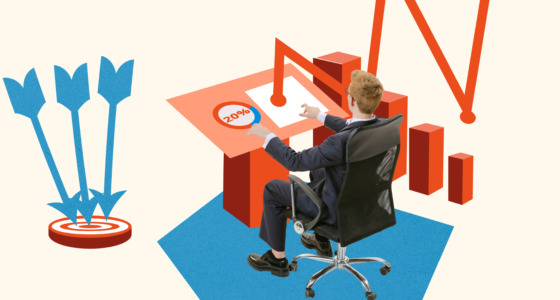

As a trader, you live and die by your edge. Your edge separates you from the masses and allows you to generate consistent profits over time. Without an edge, you are simply gambling in the markets. With an edge, you have a systematic and repeatable process for identifying high-probability trading opportunities. Developing a trading edge is part art and part science. Finding an approach that aligns with your trading strengths and objectives requires diligent work and continuous refinement. You must discover your edge to rise above mediocrity and achieve mastery as a trader. This article provides a roadmap for finding your edge in trading to gain an advantage and beat the markets.
What Is Edge in Trading: Defining Your Advantage
To achieve results in the markets, you need an edge that gives you an advantage over other traders. Your edge could be access to better information, advanced technical skills, or a trading strategy with a statistical edge.
Having an informational edge means obtaining data and insights before other traders. This could be from proprietary analytics, news alerts, or an extensive network of industry experts. Technical traders develop an edge by mastering chart patterns, indicators, and trading platforms. They uncover opportunities that others miss.
The most consistent edge comes from a trading strategy with a statistical advantage. This means your strategy has a positive expected value over time. Key factors for a statistical edge include:
An edge is what separates the skilled trader from the novice. Defining and refining your advantage, whether informational, technical, or statistical, is key to good trading results. With a proven edge, you can achieve consistent profits and beat the markets.
Types of Edge in the Markets
To gain an edge in the markets and consistently beat the averages, you need to find an advantage that sets you apart. There are several types of edges you can develop.
Information Edge
Having an information edge means obtaining data and knowledge about a stock or market before others. This could be insider information (which is illegal) or doing extensive research to uncover opportunities. Keeping up with industry news, following key companies, and analyzing financial reports can help gain an information edge.
Analytical Edge
An analytical edge comes from having a superior method of analyzing data to detect patterns, trends, and opportunities. Some examples include:
- Technical analysis – Analyzing charts and technical indicators to determine entry and exit points.
- Quantitative analysis – Using mathematical and statistical modeling to uncover relationships between variables that impact stock price.
- Behavioral analysis – Studying psychological behaviors and biases of investors to predict their impact on the markets.
Developing expertise in a specialized area of analysis or creating a unique combination of multiple techniques are ways to achieve an analytical edge.
Execution Edge
Finally, an execution edge refers to having a systematic process for making trading decisions and managing positions that is highly efficient and effective. This could include:
- Stringent risk management – Strictly controlling losses and maintaining a favorable risk-reward ratio.
- Precise timing – Executing trades at the optimal points to maximize gains and minimize risks.
- Disciplined rules – Following a predetermined set of rules to eliminate emotional decision-making.
With hard work and persistence, you can develop one or more of these edges to achieve results in the stock market. But never stop improving because edges can quickly disappear as others catch on and markets change.
How to Discover Your Unique Trading Edge
To find your unique edge in trading, you must determine what works specifically for you based on your trading style, risk tolerance, and goals. Every trader is different, so your edge will be personal to you. Here are some tips to help discover your trading edge:
Analyze Your Trading History
Review your trading history to determine where you’ve made and lost money. Look for patterns and commonalities in your most profitable trades. The methods and strategies that have yielded the most gains for you in the past may indicate your edge. Conversely, losing trades may highlight weaknesses you need to avoid or improve.
Identify Your Strengths and Weaknesses
Knowing yourself as a trader is key. Are you more comfortable with day trading or long-term investing? Do you prefer technical or fundamental analysis? What timeframes and markets do you trade best in? Look inward at your skills, talents, tendencies, and experiences as a trader. Play to your strengths and work to minimize your weaknesses. Your edge will capitalize on what you do best.
Choose a Trading Strategy That Suits You
Many trading strategies and methodologies exist, like trend following, mean reversion, momentum, etc. Select a strategy that matches your trading style and that you fully understand. The strategy that resonates most with you and that you can execute consistently may become your edge. Refine and optimize the strategy over time through practice and evaluation.
Define Concrete Entry and Exit Criteria
Establish specific rules and parameters for entering and exiting your trades to provide an advantage. Your criteria should be based on your analysis and strategy. Entry and exit rules that are too subjective or open to interpretation will not yield an edge. Precise and replicable criteria allow you to trade confidently based on logic, not emotion.
Discovering and developing your trading edge is an ongoing process of self-reflection and refinement. With deliberate practice and persistence, you can determine an edge that gives you an advantage and consistency in the markets. But you must be willing to put in the effort required to know yourself as a trader truly. Your edge is out there – you just have to find it.

Testing and Refining Your Edge Over Time
To determine if you have a true edge in the markets that can generate consistent profits, you must test and refine your trading methodology over time. Backtesting involves applying your trading rules to historical data to see how they would have performed in the past. This can help determine if your edge is “real”. However, past results do not guarantee future performance.
Continue monitoring and evaluating your trading performance to enhance your edge. Some steps to take:
- Trade your system in a simulated trading account before using real money. This lets you determine if your edge translates to live market conditions with no monetary risk.
- Start with a small position size as you begin live trading. This minimizes losses while you assess if your edge is viable and make refinements. Gradually increase your position size as your edge proves profitable.
- Record and analyze all of your trades to determine weaknesses and make enhancements. Look for any patterns in losing trades and adjust your system accordingly. For example, you may need to tighten your stop-loss rules or avoid certain market conditions.
- Stay up to date with market changes that could impact your edge. For example, changes in monetary policy, technology, or market structural changes could influence market behavior and reduce the efficacy of your current trading approach. You may need to make modifications to account for these external factors.
- Consider diversifying into different, unrelated trading systems or strategies. This avoids overreliance on any single approach and reduces volatility in your overall returns. But only deploy new strategies after thoroughly testing and validating an edge.
With continuous monitoring and refinement, you can maintain and even improve your edge over time. But remain vigilant, as edges can deteriorate or disappear altogether if market dynamics shift significantly.
Maintaining Your Edge Through Discipline and Risk Management
To maintain your edge in trading, discipline, and risk management are key.
Consistency Is Key
Adopting a consistent routine and sticking to your trading plan is essential. Review your strategy and reasons for entering a trade before executing. Set entry and exit rules and follow them. Don’t let emotions cloud your judgment.
Manage Your Risk
Risk management ensures you preserve your capital. Set a maximum loss amount per trade, e.g., 2% of your account value. Use stop losses for each position to limit losses if the market moves against you.
Diversify your portfolio across securities and sectors to avoid concentration risk. Don’t put all your eggs in one basket. Review and rebalance positions regularly.
Continuous Learning
The market is constantly changing, so you must adapt. Stay current with trends, news, and data on securities, sectors, and macroeconomic factors. Learn from your mistakes and losses. Refine and improve your strategy over time based on experience and insights gained.
Education and skill development are unending pursuits. Expand your knowledge of technical and fundamental analysis. Study the strategies of successful traders. Take courses on trading psychology and risk management.
Maintaining an edge requires purpose and persistence. With discipline, risk management, continuous learning, and consistent practice, you can achieve sustainable results as a trader, even as the markets shift and evolve. Stay determined, stick to the fundamentals, and control your emotions. That is the key to achieving excellent results in the markets.
Conclusion
As you work to determine your unique edge in the markets, remember that finding it is a journey, not a destination. Your edge will evolve as you gain more experience and insight. Stay dedicated to continuous learning and improving your craft. Analyze your successful and unsuccessful trades to understand better the conditions where your strategies excel and falter.
An edge built on hard-won wisdom and expertise will serve you far better than chasing the latest fad or “hot tip”. You can achieve the discipline and intuitiveness that mark the expert trader with deliberate practice and persistence. Believe in your abilities, trust your preparation, and have confidence in the edge you have developed. The markets reward those willing to try to attain a sustainable competitive advantage.










